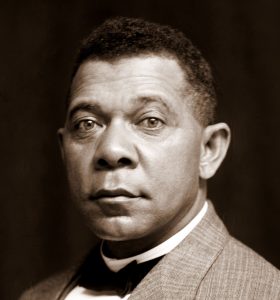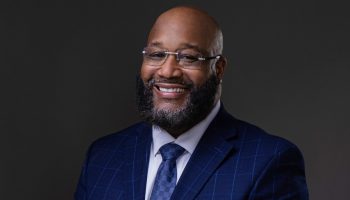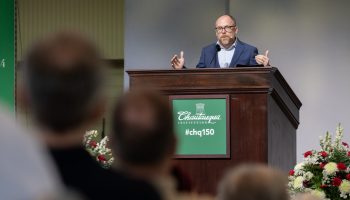The story of public education in the United States is, like much of American history, a story of racial injustice and how such injustice has been addressed and, sometimes, overcome.
In 1740, the colony of South Carolina made it a crime to teach a slave to read or write. Other colonies in the South followed suit, and by 1835, with the passage of a law in North Carolina, the education of African-Americans was, for all intents and purposes, illegal throughout the South. Only with Reconstruction, following the Civil War, were black children allowed to go to school, and then, to black schools. In 1895, the Supreme Court handed down a decision calling for “separate but equal” education for all. In the South, and much of the North, that really meant separate, but not equal.

About 20 years after that ruling, Booker T. Washington and Julius Rosenwald, two men from widely different backgrounds, came together to try to right a historic wrong through the creation of schools for black children.
At 3:30 p.m. Tuesday in the Hall of Christ, Gary Moore, the director of graduate programs for agriculture and extension education at North Carolina State University, will discuss the remarkable contribution of those men in a program called “Booker T. Washington and Julius Rosenwald: Transforming Education for Black Children in the South — the Story of the Rosenwald School Program,” part of the Oliver Archives Heritage Lecture Series. Moore has become a Chautauqua favorite over the years, and is known for his informative (and funny) talks on the history of the outhouse.

When he met Rosenwald in 1912, Washington was perhaps the most prominent and influential African-American man in the nation, Moore said. Born to into slavery in Virginia in 1856 (the exact dates were always hazy, even to him), Washington was the son of a black seamstress and, it is believed, a white man from a nearby plantation. After the Civil War, Washington and his mother moved to West Virginia, where he taught himself to read and write and first attended school. He later attended seminary in Washington, D.C., and college at the Hampton Institute in Virginia. The president of that college was so impressed with Washington that he named him the first leader of the newly founded Tuskegee Institute in Alabama in 1881.
At Tuskegee, Washington created a curriculum based on hands-on, practical learning, Moore said. His was as much a social as an educational philosophy, which was encapsulated in a speech he made in 1895 known as “the Atlanta Compromise.” In it, Washington called on African-Americans to pursue education, entrepreneurship and hard work to improve their collective position. He eschewed direct confrontation against the rigid segregation imposed during the Jim Crow era, a position that later left him at odds with other black leaders, including W.E.B. Du Bois and the NAACP. The speech made Washington famous, and he was sought out as a speaker throughout the country. At those appearances, he raised money for the private Tuskegee Institute, and it was on such a mission that he met Rosenwald.
Rosenwald was the son of Jewish immigrants from Germany. A self-made success in the clothing business, he became president of Sears, Roebuck and Co. in Chicago and bought half the business. As a Jew, Rosenwald had felt the sting of persecution himself and was deeply troubled by the discrimination by whites against black people. He had read and admired Washington’s best-selling autobiography, Up From Slavery, and gave Washington $25,000 to build six elementary schools for black children in Alabama.
At the time, Moore said, public school spending in the South was based on the taxes communities paid. White communities were vastly better off financially than black communities, and paid more taxes — money that went to their schools. Black people paid far lower taxes and, subsequently, money for their schools was about 20 percent of that for white schools, Moore said. The ramshackle black schools in most of the South relied on hand-me-down desks and books from white schools. Picnics, suppers and other fundraisers could raise only so much money, Moore said, and so Rosenwald’s philanthropy made an enormous financial difference.
The architectural plans for the six schools were carefully conceived, Moore said, with uniform floor plans and blueprints. The buildings all featured extra-large windows to let in the maximum amount of light and fresh air, and had modern sanitary restrooms to promote good health. Shops were built for vocational training, and housing was built for teachers to live near the schools. The ratio of teachers to students rose drastically. And the schools became social and educational centers for the entire community. Curricula and teaching methods were as carefully crafted and universally implemented as the building blueprints, Moore said.
“They really thought this out and followed the directions to a T,” he said.
The schools were so successful that Washington and Rosenwald built more. And more. And more.
After Washington’s death in 1915, Rosenwald set up operations at Fisk University in Nashville, Tennessee. Between 1917, when the Julius Rosenwald Fund was incorporated, and 1932 when it dissolved, having accomplished its goal, the philanthropic foundation that became known as the Rosenwald Schools built nearly 5,000 new schools for nearly 700,000 black children in 15 states at a cost of nearly $30 million, according to the National Trust for Historic Preservation. The foundation also built dozens of YMCAs.
“Rosenwald was a modest man,” Moore said. “He didn’t want the schools named after him.”
But that is how they became universally known. And the Rosenwald Schools became models not just for black schools, but for white schools in the South and nationwide. Franklin D. Roosevelt held them up as examples of academic excellence during his administration. The Works Progress Administration built new schools during the Depression held to the tried-and-true specifications set out decades earlier. Eventually, more American public schools came to resemble those developed by Rosenwald and Washington than the ones they were designed to replace.
The unlikely partnership between Washington and Rosenwald had worked.
“They accomplished what they set out to do,” Moore said.




